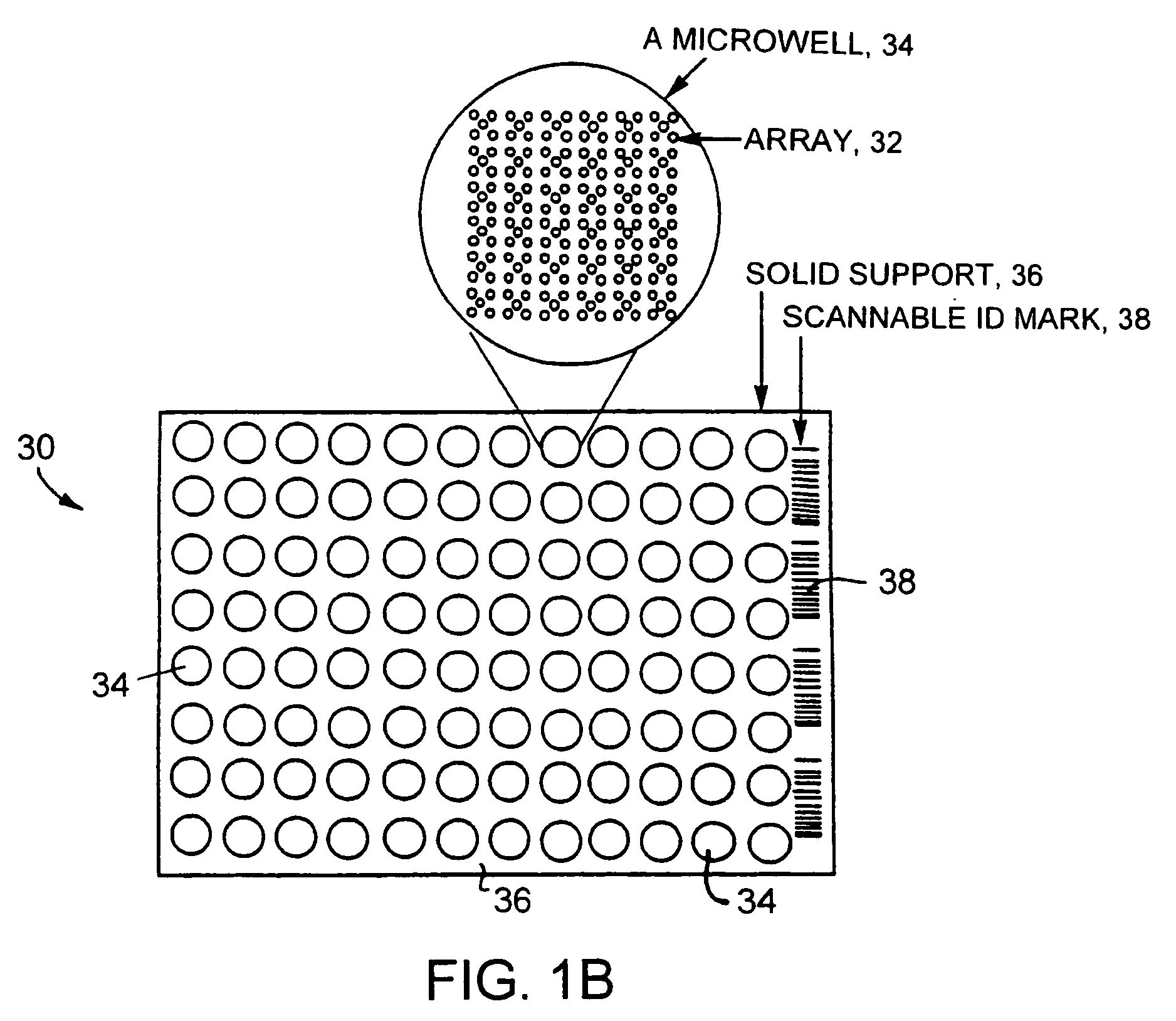Clinically intelligent diagnostic devices and methods
a diagnostic device and intelligent technology, applied in the field of medical diagnosis, can solve the problems of difficult diagnosis based on only symptoms, time-consuming, cumbersome, slow, etc., and achieve the effects of reducing test costs, reducing test costs, and extending the spectrum of information
- Summary
- Abstract
- Description
- Claims
- Application Information
AI Technical Summary
Benefits of technology
Problems solved by technology
Method used
Image
Examples
example 1
Preparation of Clustered Probe Arrays on Various Solid Supports
[0195] A blank 3D-Link™ slide (Surmodics), which contains NHS-ester groups at the surface of the slides, is used in this example. The slide is placed in a chamber for arraying of probes onto the slide surface. Probe molecules (ZFPs and other polypeptides) are dissolved in a bicarbonate buffer at pH 8.3, and are spotted onto the glass slides using an arrayer. All the probe molecules contain an amine group for reaction with the slide surface. The spotting solution can also contain chemicals that have low vapor pressure (high boiling point) and that preserve the activity of probe molecules (such as glycerol, trehalose, and polyethylene glycol). The spotting is done under controlled conditions (such as humidity, in one instance around 70% relative humidity, temperature, for example around 4° C., pressure, and air-flow).
[0196] After the probes are spotted, the slides are put in the development chamber for 1-12 hours. The ch...
example 2
Jaundice (Liver Failure) Kit
[0208] This kit allows comprehensive, cost-effective, rapid diagnosis of numerous diseases / conditions based on a patient's clinical presentation of jaundice / liver failure. Diagnosis of genetic, autoimmune, and infectious diseases is based on the precise detection of specific gene mutations or other markers (such as microbial-specific sequences, or autoreactive antibodies) using DNA, RNA, and protein (spotted antigenic proteins and specific mAbs) chips. Jaundice kits are focused on the etiologic considerations of jaundice. In addition, therapeutic markers may be included to test for different potential therapeutic options. Briefly, one or more of three groups of etiological conditions are evaluated: A) autoimmune hepatitis, B) viral-induced hepatitis, and C) genetic diseases causing jaundice and / or liver enlargement. See, e.g., Feldman: Sleisenger & Fordtran's Gastrointestinal and Liver Disease, 6th ed. (W.B. Saunders Company 1998); McFarlane, “IG: The Re...
example 3
Fever / Skin Rash / Weight Loss (Autoimmune) Kit
[0229] This kit allows comprehensive, cost-effective, rapid diagnosis of numerous diseases / conditions based on a patient's clinical presentation of autoimmunity (systemic autoimmune diseases have frequently overlapping clinical pictures consisting of fever, skin rash, skin discoloration, and weight loss). Diagnosis of autoimmune diseases is based on the precise detection of autoreactive antibodies, specific gene mutations or other markers (such as autoimmune prone HLAs) using DNA, RNA, live cells, and protein (spotted antigenic proteins and specific mAbs) chips. Briefly, one or more of three groups of etiological conditions are evaluated: A) Systemic and organ-specific autoimmune diseases, B) HLAs that are associated with specific autoimmune diseases, C) Detection of gene mutations that result in the autoimmune syndrome, D) Deficiencies of early and late complement components associated with autoimmune diseases, and E) Therapeutic markers...
PUM
| Property | Measurement | Unit |
|---|---|---|
| pH | aaaaa | aaaaa |
| temperature | aaaaa | aaaaa |
| concentration | aaaaa | aaaaa |
Abstract
Description
Claims
Application Information
 Login to View More
Login to View More - R&D
- Intellectual Property
- Life Sciences
- Materials
- Tech Scout
- Unparalleled Data Quality
- Higher Quality Content
- 60% Fewer Hallucinations
Browse by: Latest US Patents, China's latest patents, Technical Efficacy Thesaurus, Application Domain, Technology Topic, Popular Technical Reports.
© 2025 PatSnap. All rights reserved.Legal|Privacy policy|Modern Slavery Act Transparency Statement|Sitemap|About US| Contact US: help@patsnap.com



